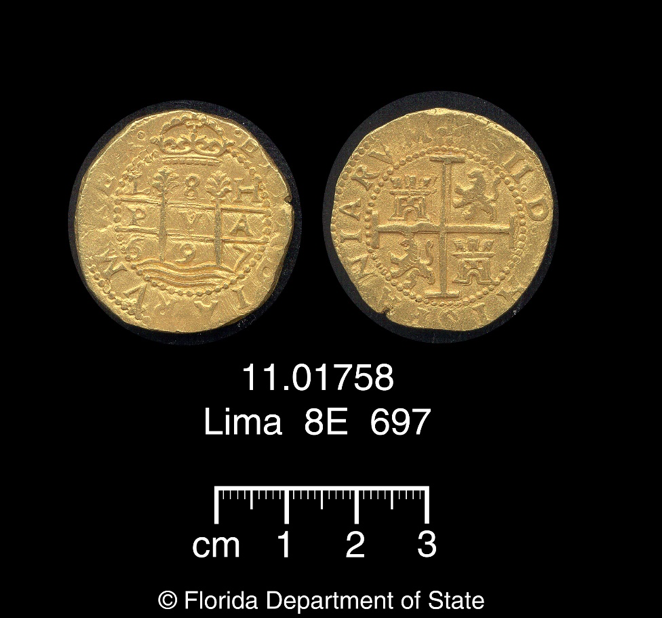“The Earliest Lima 8 Escudos in the Florida Collection”
This post is the second in a series that will explore some of the highlights of the magnificent Florida State Collection of Spanish Colonial artifacts and coins.
The Lima mint began striking a gold coinage in August of 1696, almost a decade after permission for a coinage in gold had been granted by Carlos II. Damage from earthquakes in 1687 and 1690 is said to have set back the launch of the gold coinage, but other factors were almost certainly involved in the delay. The gold mintage of 1696 was modest (131,916 pesos) and only a few specimens survive. No eight escudos of 1696 have been found on the Fleet, though three 1696 two escudos, including Florida Collection coin #11.01670, have been recovered from Fleet sites. The earliest Lima eight escudos in the Florida Collection, a single 1697, is pictured above.
Exact mintage figures for the denomination are not available, but we estimate about 8500 eight escudos were stuck at Lima in 1697. Seven are known to have survived, four of them from the Fleet. The surviving coins show us two pillar and three cross dies in use. Neither of the pillar dies are overdates. The cross side features a redesign of the plain, real-style cross of 1696. Beginning in 1697, and until the coming of the milled Portrait coinage in 1751, Lima uses a Jerusalem Cross with castles and lions in its angles as the reverse design.
The diameter of this 1697 varies between 31.5 and 32.5 mm. Though there is some irregularity along the edge, it is a reasonably round coin. Two of the 1697 onzas in private hands have maximum diameters approaching 34 mm and are even rounder. Alan Craig in his Spanish Colonial Gold Coins in the Florida Collection (2000) contrasts the roundness of Lima gold with the irregular, cob-style planchets used at Mexico City and Santa Fe. “It is likely,” he says, “that the Lima gold workers developed a unique system of producing a planchet that was both nearly round and close to required weight….” (p. 20). That is so! Even a brief examination of the edge of onzas like the 1697 shows us that they were not scissored from strips and adjusted with further linear cuts. That is how so-called “cobs” were prepared at Mexico City and Santa Fe, but it is not how the round planchets were produced at Lima.
“Each cob coin,” Craig tells, “was struck by hand using heavy lead-filled mallets on a gold or silver planchet, also handmade and of completely random form…” (p.12). Again, Craig is correct: a cob is a coin struck by hand on a planchet whose shape can be anything its proper weight allows. Mexico City struck gold cobs from 1679 until 1732. Santa Fe struck gold cobs from 1627 into the 1750’s. Both of those mints in the final years of their hand-struck coinages began to produce nearly round, not cob, planchets. From the beginning of its gold coinage in 1696 Lima never used cob planchets for its gold coinage.
Phil Flemming, director of the 1715 Fleet Society
